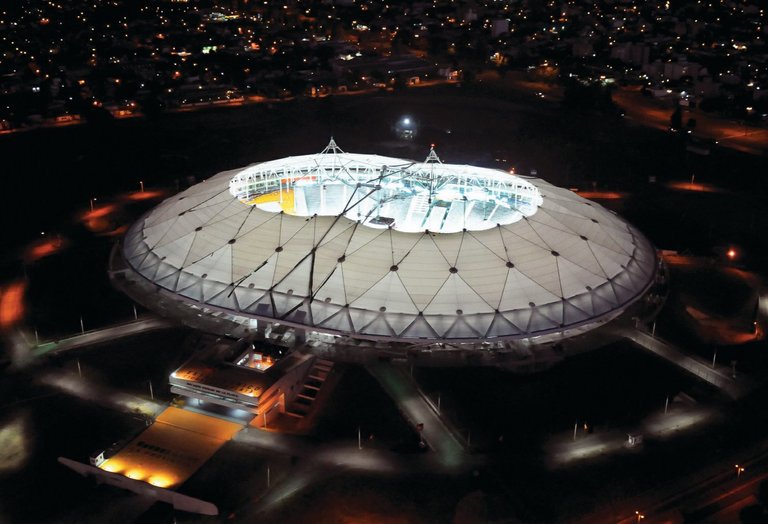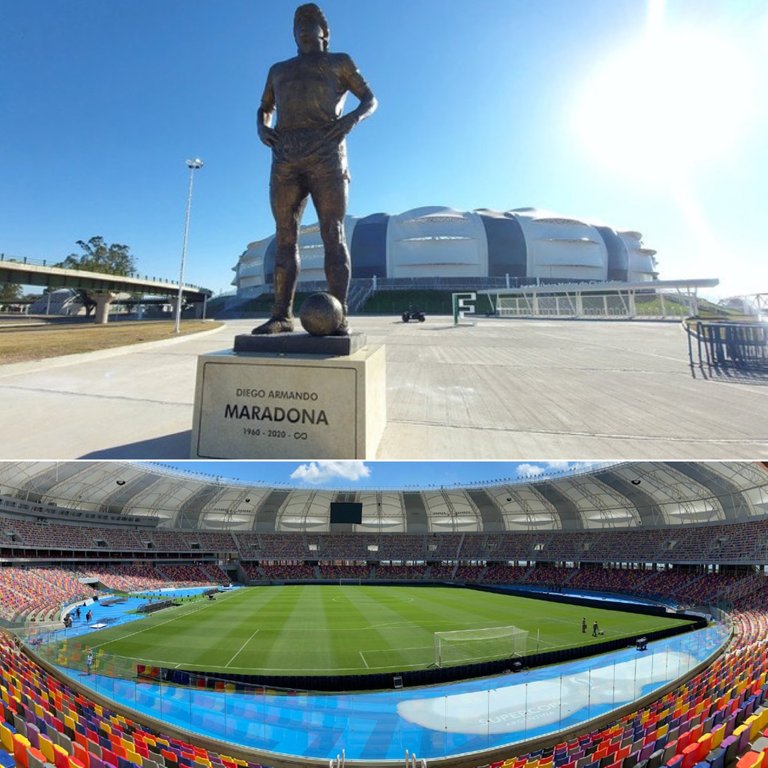El estadio de fútbol que no quieren utilizar

Un mes atrás finalizaba el mundial de fútbol Sub20 donde Uruguay consiguió el título por primera vez en su historia.
El encuentro final se disputó en el Estadio Único de La Plata cuyo nombre oficial es Diego Armando Maradona y donde Uruguay venció por la mínima diferencia a la excelente selección de Italia que había dado una verdadera lección de fútbol nada menos que frente a Brasil en el primer partido de la fase de grupos.
Por supuesto las noticias sobre el campeón y ese encuentro final han sido escritas y reproducidas en todo el mundo donde el fútbol es uno de los deportes preferidos, ni que hablar de los medios de comunicación de Uruguay e Italia, los finalistas.
De lo que generalmente no se habla es del estadio donde se disputó el encuentro, si por supuesto se mencionan todas las sedes y se hace un repaso de como son y que comodidades tienen antes y durante el certamen, pero no mucho más que eso.
En ocasiones algunos de esos estadios tienen historias y anécdotas atrapantes, los hay míticos y de renombre donde se han disputado encuentros y torneos que se convirtieron en leyendas, también hay otros que pasan desapercibidos, tal es el caso del Diego Armando Maradona, más conocido como estadio Único de La Plata, aunque de único no tiene nada, solo es esa palabra que representa una idea frustrada.
La primera idea de construir un estadio que pudiera albergar los partidos de los dos principales equipos de fútbol de La Plata, me refiero a Estudiantes y a Gimnasia y Esgrima, mi equipo favorito, se lanzó en el año 1947, inclusive el gobernador de aquella época de nombre Mercante llegó al punto de expropiar las tierras en donde hoy se encuentra emplazado. Sin embargo, esa idea quedó estancada solamente en eso.
Hubo que esperar hasta el año 1972 para que el proyecto archivado, aunque nunca olvidado completamente, tomara nuevas fuerzas, principalmente debido a la elección de la Argentina para ser sede del mundial 1978 y con la esperanza de ser elegido entre las diversas propuestas, se realizó un concurso que fue ganado por un reconocido estudio de arquitectos locales, por razones económicas y de infraestructura de transporte insuficientes nuevamente el proyecto se guardó para continuar acumulando polvo. Paradójicamente, el mismo estudio de arquitectos construyó en tiempo y forma el estadio de Mar del Plata que fue escenario de varios partidos de aquel mundial.
Recién en 1993 volvió a reflotar la idea y se realizó un nuevo concurso para su desarrollo y construcción, esta vez fue en serio y el arquitecto ganador ideó la forma de amalgamar en un único lugar la historia y la idiosincrasia de los dos clubes ya que compartirían el espacio, la pasión y la rivalidad. Lo pensó como dos círculos unidos, como un empate cero a cero.
Hubo intentos de comenzar la construcción en 1995 y luego en 1997 aunque recién en 1998 los primeros trabajos vieron la luz. Se presupuestó en 50 millones de dólares y finalmente fueron 82 los insumidos en su desarrollo. Hubo períodos donde no se avanzó en absoluto, aunque finalmente en 2003 el estadio estuvo habilitado para el objetivo por el cual fue construido.

Por razones que solo pueden explicarse en un país como el nuestro dónde muchísimas veces la burocracia, el sin sentido y la improvisación le ganan al talento innegable de los habitantes, el techo realizado en fibra de vidrio y teflón por una compañía extranjera, estuvo años demorado en la aduana y recién fue colocado muchísimo tiempo después de su inauguración.
Los grandes retrasos le jugaron en contra y tanto Estudiantes como Gimnasia en todo ese tiempo remodelaron y reconstruyeron gran parte de sus estadios vetustos y pensados para otra época, como corolario ninguno de los dos equipos ahora están interesados en utilizarlo, cada uno a su manera se las arreglaron e invirtieron fuertes sumas de dinero y ambos tienen sus estadios bien presentados, sus socios y simpatizantes se niegan rotundamente a abandonarlos, demasiadas historias y emociones se guardan en las gradas de ambos.
Como muestra del escaso interés que tenían los dos principales equipos de la Plata por jugar allí, el debut del estadio para un partido de fútbol fue entre Villa San Carlos y Acassuso, dos equipos de la primera C del fútbol local, asistieron 6.000 espectadores en un recinto que puede albergar más de 50.000. Alguna vez, más por compromiso y presión que por necesidad, jugaron algún clásico platense.
Por consiguiente, el estadio Único de La Plata puede pasar meses sin que se lo utilice y cuando se lo hace generalmente es para albergar algún evento que nada tiene que ver con lo que sus impulsores pensaron. Ha recibido a los Rolling Stones, a Paul McCartney, allí se coronaron como campeones (por enésima vez) del Rugby Championship los All Blacks, hay eventualmente recitales de otras bandas locales e internacionales, se utilizó como vacunatorio durante la pandemia de Covid y alguna que otra vez se presentó la selección nacional de Fútbol para disputar encuentros amistosos.
Recién este año un evento futbolístico de calidad como fue el mundial Sub20, permitió al Único de La Plata mostrar que es un excelente marco para la disputa de encuentros y torneos de calidad internacional.
Esta es la historia de un estadio moderno y bello, problemático, poco utilizado y contradictorio. Una muestra acabada de porqué la Argentina es un jeroglífico que pocos comprenden.
The football stadium they don't want to use
A month ago the U20 World Cup ended and Uruguay won the title for the first time in its history.
The final match was played at the Estadio Único de La Plata whose official name is Diego Armando Maradona and where Uruguay beat the excellent Italian team by the slightest difference, which had given a true football lesson against Brazil in the first match. group stage match.
Of course, the news about the champion and that final match have been written and reproduced worldwide where soccer is one of the favorite sports, not to mention the media in Uruguay and Italy, the finalists.
What is generally not talked about is the stadium where the match was held, if of course all the venues are mentioned and a review is made of what they are like and what amenities they have before and during the event, but not much more than that.
Sometimes some of these stadiums have captivating stories and anecdotes, there are mythical and renowned ones where matches and tournaments have been held that became legends, there are also others that go unnoticed, such as the case of Diego Armando Maradona, better known as "Único de La Plata" stadium, although it has nothing unique about it, it is just that word that represents a frustrated idea.
The first idea of building a stadium that could host the matches of the two prominent soccer teams in La Plata, I mean Estudiantes and Gimnasia y Esgrima, my favorite team, was launched in 1947, including the governor of that time, Domingo Mercante, reached the point of expropriating the lands where it is located today. However, that idea was stuck only in that.
It was not until 1972 that the archived project, although never completely forgotten, took on new strength, mainly due to the choice of Argentina to host the 1978 World Cup and with the hope of being chosen among the various proposals, it was carried out a competition that was won by a renowned studio of local architects, for economic reasons and insufficient transport infrastructure again the project was saved to continue gathering dust. Paradoxically, the same studio of architects built the Mar del Plata stadium on time and form, which was the scene of several matches of that World Cup.
It was not until 1993 that the idea was revived again and a new competition was held for its development and construction, this time it was serious and the winning architect devised the form and amalgamated in a single place the history and idiosyncrasy of the two clubs since they would share space, passion, and rivalry. He thought of it as two joined circles, like a nil-nil tie.
There were attempts to start construction in 1995 and then in 1997, although it was not until 1998 that the first works came to light. It was budgeted at 50 million dollars, and 82 were consumed in its development. There were periods where no progress was made at all, although finally in 2003 the stadium was enabled for the purpose for which it was built.
For reasons that can only be explained in a country like ours, where bureaucracy, nonsense, and improvisation often win out over the undeniable talent of the inhabitants, the roof made of fiberglass and Teflon by a foreign company, was delayed for years. in customs and it was only placed a long time after its inauguration.
The great delays played against him and both Estudiantes and Gimnasia in all that time remodeled and built a large part of their dilapidated stadiums and designed for another era, as a corollary neither of the two teams is now interested in using it, each one in their own way they fixed them up and invested large sums of money and both have their stadiums well presented, their partners and supporters flatly refuse to abandon them, too many stories and emotions are kept in the stands of both.
As a sign of the little interest that the two main teams from La Plata had in playing there, the debut of the stadium for a soccer match was between Villa San Carlos and Acassuso, two teams from the first C of local soccer, attended by 6,000 spectators in an enclosure that can accommodate more than 50,000. Sometimes, more due to commitment and pressure than necessity, they played classics from La Plata.
Consequently, the "Único de La Plata" stadium can go months without being used and when it is used it is generally to host an event that has nothing to do with what its promoters thought. It has received the Rolling Stones, Paul McCartney, there the All Blacks were crowned champions (for the umpteenth time) of the Rugby Championship, there are eventually recitals by other local and international bands, it was used as a vaccination during the Covid pandemic and some that once again the national soccer team appeared to play friendly matches.
Just this year, a quality soccer event such as the U20 World Cup allowed the Único de La Plata to show that it is an excellent setting for the dispute of international quality matches and tournaments.
This is the story of a modern and beautiful stadium, problematic, little used, and contradictory. A finished sample of why Argentina is a hieroglyph that few understand.
Héctor Gugliermo
@hosgug
@hosgug
https://twitter.com/FullDeportes6/status/1677352054149218310?s=20
@hosgug
https://leofinance.io/threads/view/fulldeportes1/re-leothreads-bgjihj9h
Que interesante historia, la conocía pero no con tantos detalles.
Gracias por compartirla @hosgug
Gracias a ti por leerla y comentar.
Saludos @viviana.fitness
Cómo siempre nos traes contenidos fuera de la común. No conocía la historia sobre este estadio donde Uruguay se consagro por primera vez en el mundial sub-20 que se disputó este año en Argentina.
Gracias por compartir esto con nosotros en la comunidad. Cómo siempre un magnífico trabajo mi estimado.
¡Saludos!
Muchas gracias por tus conceptos y por pasar por mis publicaciones
Un saludo @franz54 !!!